Nothing will put a dent in your carrot yields quite like disease. Not even a rabbit who frequently nibbles on them while saying, “Eh… what’s up, doc?”
Confession time: back in high school, there was a time when I ate a stupidly large amount of carrots, to the point where my palms literally turned orange from the Vitamin A surplus.
I kid you not, the orange was a shade away from an Oompa-Loompa’s skin tone!

We link to vendors to help you find relevant products. If you buy from one of our links, we may earn a commission.
Anyway, that little experiment wouldn’t have been possible without access to plenty of carrots that I could consume in ridiculous quantities.
For those who want to munch on plenty of carrots themselves, you’ll have to know how to keep them healthy and disease-free while they grow.
That’s why we’ve whipped up this handy guide to some notable carrot diseases that you might encounter in your garden.
I’ll cover the causes, life cycles, and resultant symptoms, as well as how you can treat them… or even prevent them from occurring in the first place.
Here’s the list of diseases:
11 Common Carrot Diseases
For a quick refresher about how to grow carrots, sink your teeth into this guide.
It should help quite a bit, since proper cultivation promotes healthy plants that can resist many common diseases.
But it can happen that a disease comes a-knocking, and these are the most common ailments to watch out for in your carrot patch.
1. Alternaria Leaf Blight
Capable of spreading quickly and remorselessly, Alternaria leaf blight is present worldwide, wherever carrots are produced on a large scale. Perhaps even in your garden…
This disease is caused by Alternaria dauci, a fungus that is present in the environment as spores and mycelium on and/or in carrot seeds. Optimal conditions for infection are wet, moderate to warm weather. A. dauci can also persist in crop detritus.

Infected leaves exhibit greenish-brown, water-soaked lesions along the margins, which increase in size, darken to brown or black, and develop chlorotic yellow halos. Older leaves tend to develop symptoms first, and if lesions occur on the petioles, infected leaves can quickly die.
If 40 percent or more of a leaf becomes infected, it turns yellow, completely wilts, and dies. And without leaves, carrot roots won’t have the fuel they need to develop.
Avoiding overhead watering and rotating crops every two to four years can both help prevent infections.
You should also acquire certified disease-free seeds, or you can treat your seeds by placing them in hot water of about 122°F for 20 minutes prior to sowing.
Ridding your garden beds of crop detritus should help, too, as the organic debris can harbor the pathogen until it decomposes.
‘Waltham-Hi-Color,’ ‘Orlando Gold,’ and ‘Hi-Color 9’ are some resistant cultivars.
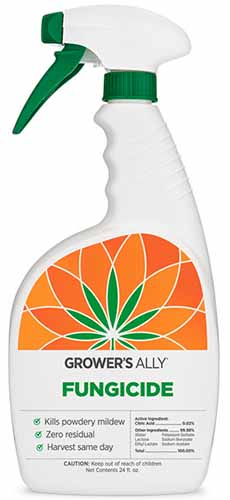
Grower’s Ally Fungicide
You can treat Alternaria by using a biofungicide containing Bacillus subtilis, or a citric-acid based fungicide such as this OMRI-listed product from Grower’s Ally, available at Arbico Organics.
Apply as soon as you notice symptoms and be sure to follow the manufacturer’s directions on the packaging.
2. Aster Yellows
A pathological foe of plants in the Asteraceae family, aster yellows can also infect carrots. Oh, joy.
This disease is caused by a bacteria-like phytoplasma, an obligate intracellular parasite that is transmitted by the aster leafhopper, Macrosteles quadrilineatus.
Active in summer, these leafhoppers pick up the phytoplasma as they feed from infected plants, only to spread it to new hosts for the rest of their lives.

Once infected, a plant will warp and become stunted. New leaves will turn yellow, old ones will turn reddish purple, and carrot roots can become deformed and distorted.
Unfortunately, there is no cure for aster yellows. You should pull infected specimens as soon as you notice symptoms, as well as any nearby weeds like dandelions that could potentially play host to the disease, and dispose of them in the trash.
You can’t prevent aster yellows without controlling aster leafhoppers. You can deter these insects with light-colored or reflective mulches, as well as cover your crops with floating row covers.
Learn more about aster yellows in our guide.
3. Bacterial Leaf Blight
This one is all thanks to the bacterium Xanthomonas campestris pv. carotae… say that five times fast!
Similar to Alternaria leaf blight, bacterial leaf blight is a seedborne disease that also survives in un-decomposed plant debris.
The initial symptoms are irregular brown lesions on leaf margins that often appear watersoaked and yellow-tinged. If you notice sticky, amber-colored fluid from the leaves or stalks, that’s a sure sign you’re dealing with bacterial leaf blight infection.

Typically, the spots converge over time into large leaf blemishes, and the petioles develop dark brown streaks. As you can imagine, all this isn’t awesome for big and bountiful harvests.
This disease spreads via splashing water and heavy dew, and develops in temperatures above 65°F, but optimal temperatures are between 77° and 86°F.
So be sure to avoid overhead irrigation, and stay vigilant when the weather starts to warm up.
Sowing resistant seed, using hot water treatments, and rotating crops every two to three years helps to prevent this disease.
Copper sulfate fungicide is an effective organic control method when applied to the leaves in one- to two-week intervals when you first notice symptoms.

Bonide Copper Fungicide
You can find Bonide Copper Fungicide available from Arbico Organics.
4. Bacterial Soft Rot
Ever had a soft, slimy carrot that you thought was gross? Then you definitely won’t like bacterial soft rot.
Bacterial soft rot is caused by the soilborne bacterium Erwinia carotovora, which survives on plant debris and enters established plantings through root or shoot wounds, often in overwatered soils and during warm spring and summer temperatures.
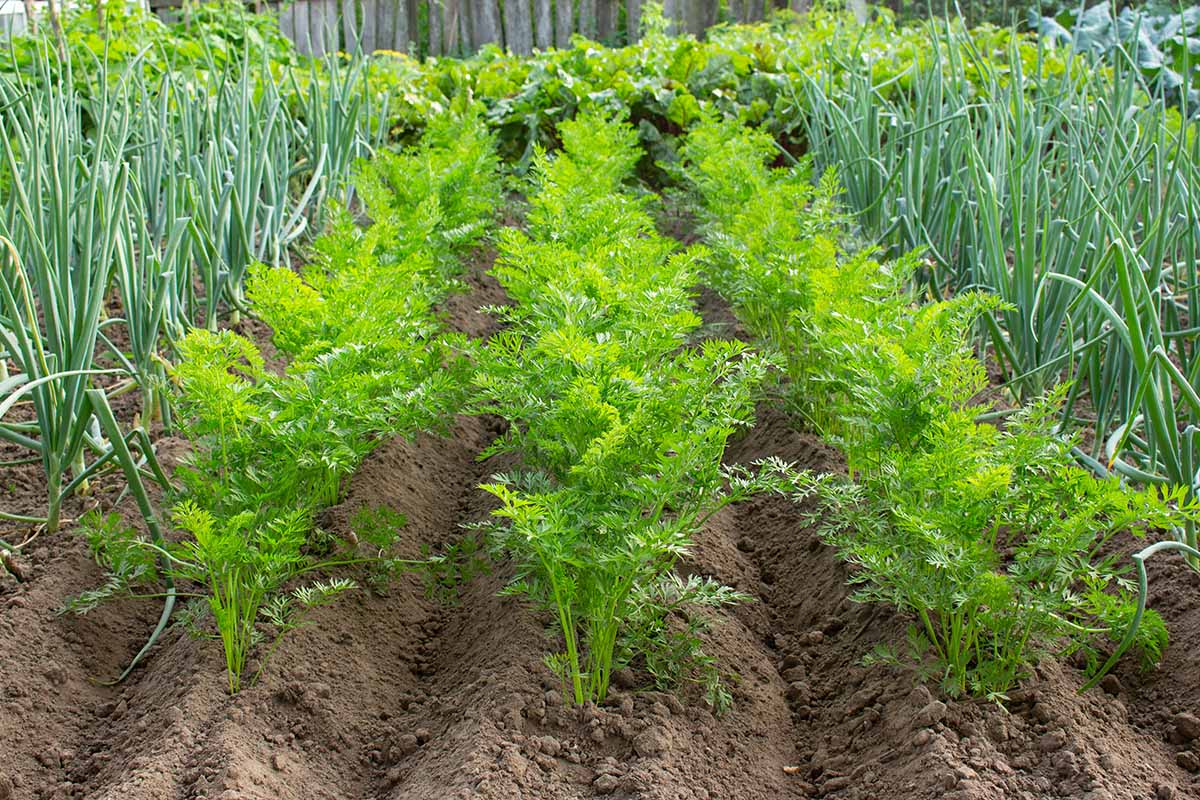
Once infected, the core of the root turns soft, watery, slimy, and foul-smelling, while the surface may remain relatively intact. The leaves of infected plants turn yellow and wilt before they eventually collapse.
To prevent bacterial soft rot, it’s important to maintain good drainage in your planting beds and avoid damaging your plants.
As the pathogen can also infect harvested carrots, handle the freshly dug roots with care and store them at temperatures of 32 to 40°F.
Washing them with chlorinated water can help kill any bacteria that may remain on the surface of the roots and be sure to store produce in a dry location.
If you notice the early symptoms, it’s worth pulling up a single carrot to check for rot. There is no cure for soft rot, and once it takes hold, your entire harvest is toast.
Learn more about soft rot in our guide.
5. Black Crown
Remember the fungus Alternaria dauci that we described earlier? Say hello to its relative, Alternaria radicina.
Capable of persisting up to eight years in soil, this fungus afflicts the crowns of infected plants, right where shoot meets root.
The leaves can show symptoms of dark brown marginal lesions, break off, or even die, while the upper portion of root will exhibit an ugly, shiny green to black color as it rots.

Seedborne as well as soilborne, A. radicina can even survive in crop detritus – it’s a pretty capable survivor, unfortunately.
The pathogen can spread throughout a stored harvest if there’s even a small amount of contamination.
Sowing resistant seeds, using hot water treatments, removing plant detritus, avoiding overhead irrigation, and storing harvests at cool temperatures – are all good prevention methods.
If you notice symptoms, foliar fungicides like the above product recommended for A. dauci can help manage symptoms, but it’s best to avoid planting in that soil for several years.
Pitch any harvested carrots with noticeable symptoms.
6. Black Root Rot
Black root rot is a disease that you probably won’t notice until harvest time. Because, y’know… the root is underground.
This one is caused by Thielaviopsis basicola, a soilborne fungus that spreads via spores, entering plant tissue via wounds or natural openings like gas-exchanging stomata or water-secreting hydathodes.
Once infected, a plant will develop irregular black lesions in random spots on the root surface.

Severe infections will cause wilting and stunted growth aboveground, but the worst part of black root rot is the resulting super-nasty carrots that no one would ever willingly consume.
If the conditions are right, the disease can even spread throughout a pile of harvested carrots.
Since an alkaline soil pH favors the survival of T. basicola, it can help to maintain an acidic pH of 5.5. Be careful not to wound your plants while gardening, either!
If you pull up your carrots and find that the roots are rotten, dispose of them in the trash.
Examine any non-symptomatic roots carefully, and rinse with cool, chlorinated water before storing them at temperatures of between 32 to 40°F.
7. Cavity Spot
Ever had cavities in your teeth? At least they weren’t caused by an oomycete… gotta count your blessings!
Overwintering as spores in the soil, Pythium species cause notable divoted lesions in mature carrots, which are generally oriented across the taproot and usually less than half an inch deep.
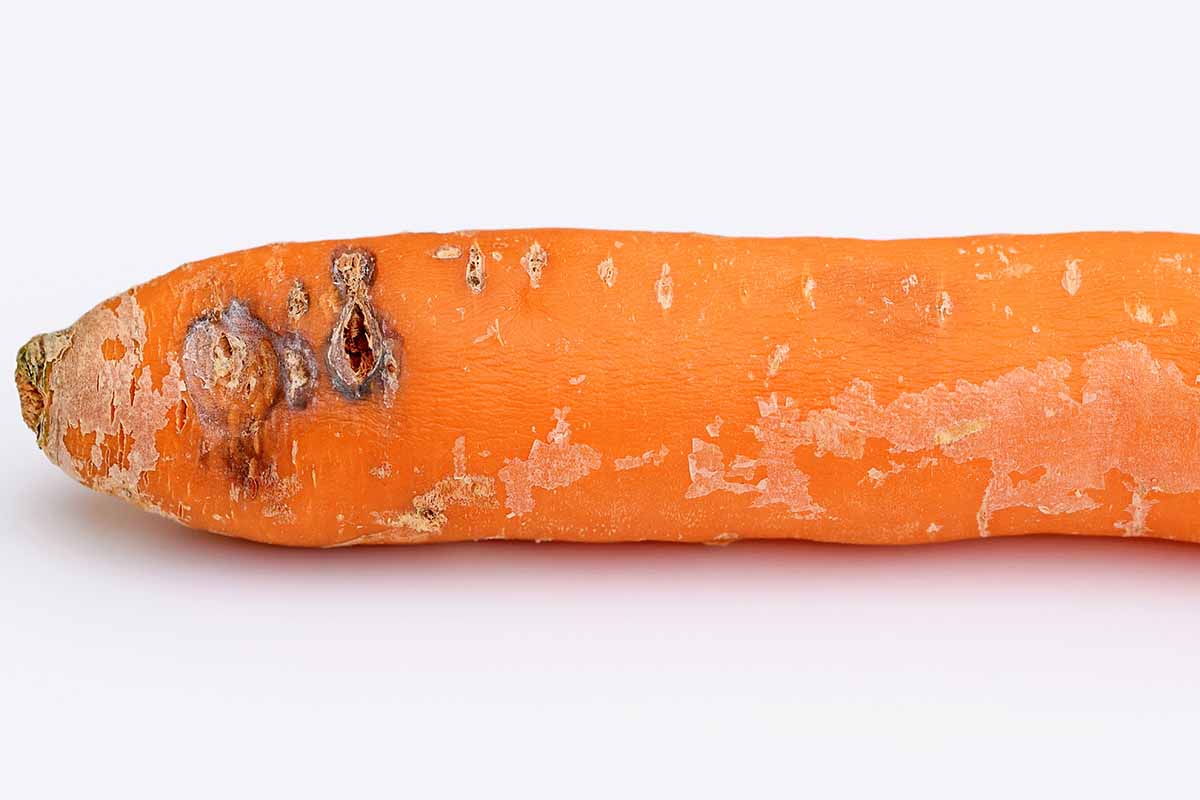
The lesions tend to be most abundant in the top third of the root. Infected plants can usually grow just fine, but they won’t be very appetizing come harvest time.
Avoid overwatering and watering from overhead whenever you can, and promptly harvest your carrots as soon as they’re ready. Rotating crops every two to three years can help, too.
There’s nothing you can do about infected roots, so pitch any that you notice upon harvest.
8. Cercospora Leaf Blight
Our third leaf blight disease on the list, this one is no less unpleasant than the others.
Caused by the fungus Cercospora carotae, Cercospora leaf blight results in leaf margins with round, brown, and water-soaked lesions, often surrounded by a chlorotic halo. In time, leaflets turn yellow and curl, while leaf petioles develop dark lesions as well.

Eventually, foliage will die off, which will leave your eventual harvests shrimpy and pitiful. Adding insult to injury, C. carotae can survive for years in seeds, soil, or plant detritus, and the disease can occur in a wide range of climates.
Using disease-free seeds or ones that you treat with copper fungicide can help to prevent infection. Also, be sure to remove leaf detritus as it accumulates, as well as rotate crops every two to three years.
Applications of a copper fungicide can be used when symptoms are first observed. If that fails to keep symptoms from becoming severe you’ll have to remove and pitch infected specimens.
9. Powdery Mildew
As a gardener, you’ve probably encountered powdery mildew before, especially in other edible crops such as celery, parsley, or dill.
This condition is caused by fungal species in the Erysiphe genus which overwinter in crop debris and adjacent weeds.
Spreading via airborne spores, the disease leaves young foliage with small circular spots of white powder that grow in size to coat the upper sides of leaves. Slight chlorosis can result, too.
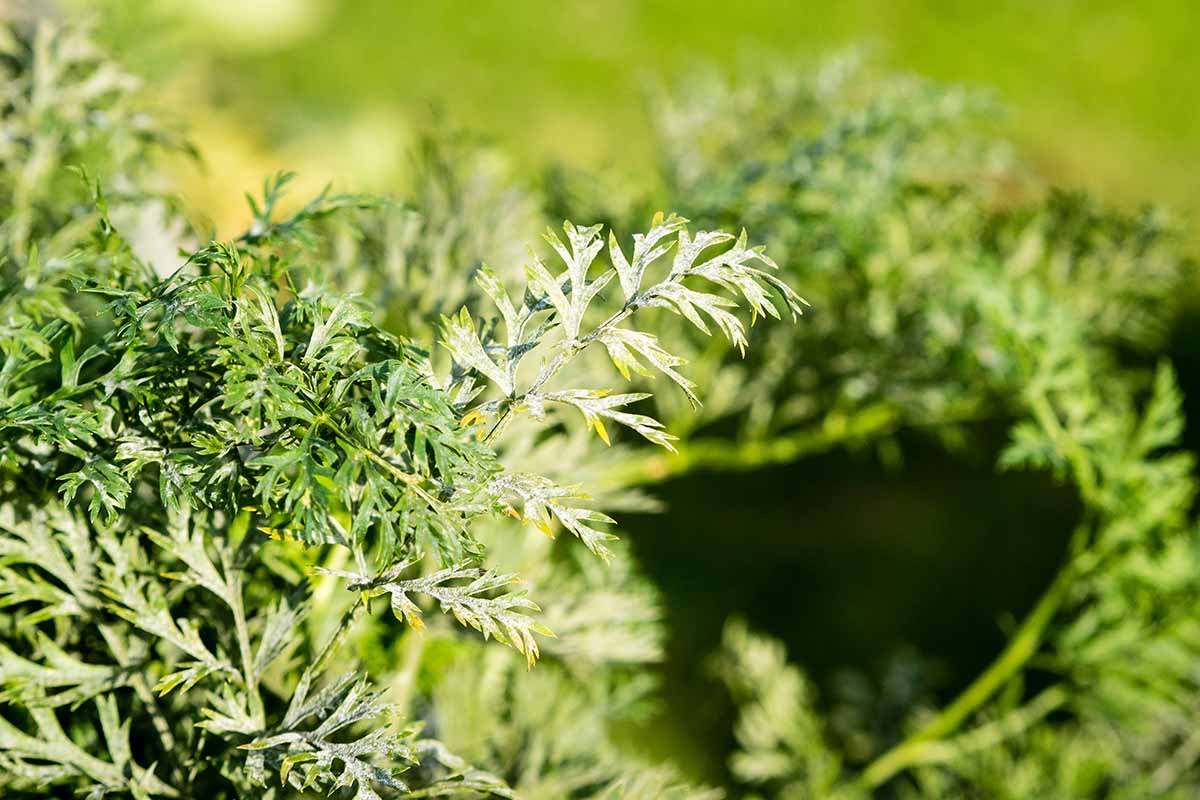
Wet, humid conditions lead to disease development, which doesn’t usually kill the plants.
However, leaves that are gross and mildew-y aren’t the best at photosynthesis, which may lead to smaller carrots come harvest time.
Resistant cultivars such as ‘Honeysnax,’ ‘Rebel,’ and ‘Siroco’ are available if powdery mildew is prevalent in your garden.
Sprays of sulfur or Bacillus subtilis are effective at combating early-season infections.
Learn more about how to deal with powdery mildew in our guide.
10. Scab
Some conditions are unappetizing and gross in name as well as appearance. Take scab, for instance.
Thanks to the bacterium Streptomyces scabies – another gross name – infected carrots are left with scab-like lesions on the surfaces of the roots.

Whether sunken or raised, near lateral roots or on the main taproot itself, these lesions make your carrots look rather ugly.
Primarily a problem in hot, dry, and alkaline soils, prevention is as simple as providing adequate irrigation and maintaining a soil pH of less than 7.0.
This disease isn’t a major problem and the roots are still edible – they just don’t look as appetizing as they could!
11. White Mold
We saved our nastiest disease (in my opinion) for last: white mold.
The causal fungus Sclerotinia sclerotiorum survives in soil as well as on infected carrots after harvest.
Once plants are infected, they’ll develop watersoaked black lesions and a fluffy white growth on the root surfaces, as well as softened and decaying root tissue. Plus, the aboveground foliage will wilt and collapse when belowground symptoms become severe.

Along with being a health hazard, a carrot with white mold on it is impossible to eat – I’d imagine your gag reflex would swiftly kick in. I mean, just look at it.
There aren’t any resistant cultivars, so preventing this nasty and widespread problem is essential.
Don’t overwater your carrots – just two weeks of oversaturated soils will promote disease development, rotate your carrot crops with grasses and onions, and inspect your stored harvests regularly for symptoms.
Copper fungicide can be used as a preventive measure during extended periods of cool, damp weather. Dispose of any infected carrots in the trash – don’t put them on your compost pile!
All Carrot, No Stick
With some know-how, the proper precautions, and a bit of dumb luck, you too can have disease-free carrots.
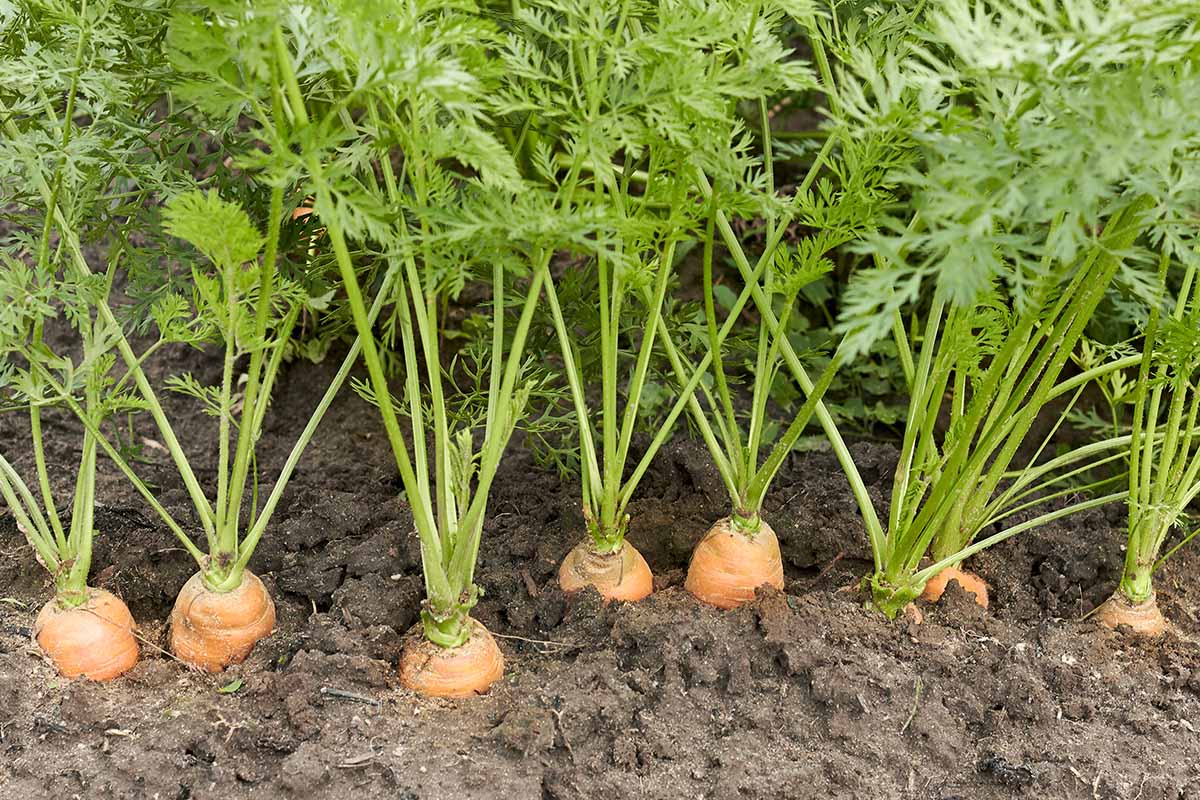
Whether edible or ornamental, a plant deserves to be kept healthy.
But at least with edibles, you’ve got some extra motivation to make that happen – no one wants to eat anything blemished and moldy. Unless we’re talking gorgonzola cheese, but that’s another story.
Got any carrot questions or disease diatribes? The comments section awaits your input.
And for more information about how to grow carrots, check out these guides next:


